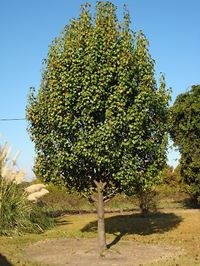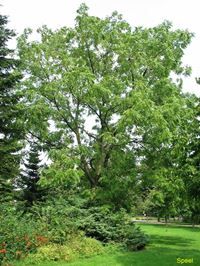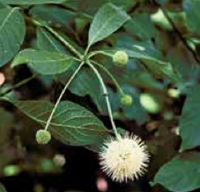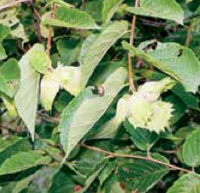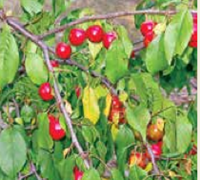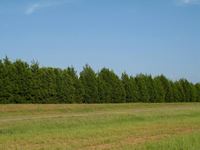Food Plot & Fruit Trees
Dunstan Chestnut

THE MOST SIGNIFICANT TREE IN AMERICAN HISTORY
The American Chestnut is the most valuable tree species in Eastern North American history. The American Chestnut once stretched from Maine, south to Georgia and west to the Mississippi. In 1904, a bark fungus was unfortunately introduced from China that destroyed over 30 million acres of valuable chestnut trees within 40 years. It is said that the American Chestnut blight was the most severe ecological disaster in American history.
The chestnut was a very important tree in many different aspects. The tree produces a large amount of mast edible by humans and wildlife. The trees were also used for everything from furniture to fence posts with its timber value equivalent to black walnut. The blight hit at an overwhelming time period of the Great Depression which affected the people and wildlife of the Appalachian Mountains. You can only imagine the millions of dollars lost in the departure of the American Chestnut.
THE ORIGINAL FOOD PLOT TREE
The American Chestnut was the primary food source tree for wildlife - deer, turkey, squirrel, bears, hogs and produced literally a TON of mast or more per acre! Chestnuts were the favored food in the fall for game, because the sweet tasting nuts were high in protein, carbohydrates, and had no bitter tasting tannins like acorns.
Deer are EVOLUTIONARILY PROGRAMMED TO EAT CHESTNUTS! Chestnuts are favored by deer over all other nuts because of their taste and nutrition. They are high in carbohydrates (40%), contain 10% high quality protein and no bitter-tasting tannin. DEER CHOSE CHESTNUTS 100:1 OVER ACORNS! In tests performed by Dr. James Kroll "Dr. Deer" at the Whitetail Research Institute in Nacogdoches, TX, Kroll reports: "Even though the wild deer at this location had never seen a chestnut in many generations, they got on the chestnuts within ONLY AN HOUR after we put them out. The deer ate the chestnuts 100:1 over the acorns! Chestnuts are deer's preferred food."
One of the reasons deer prefer chestnuts is the sweet taste of the nuts. It actually sweetens the meat of the animals that eat it. In Spain, hogs are raised on chestnuts because of the excellent flavored meat it produces - Estremaduran pork is an international delicacy. Venison from chestnut fed deer tastes like corn-fed venison, without the gamey taste of deer that feed on bitter-tasting acorns.
THE BEST CHESTNUT TREE
We offer the Dunstan Chestnut, bred by noted plant breeder Dr. Robert Dunstan, because of its disease resistance and heavy annual crops of very large, sweet nuts. Dunstan Chestnuts have been grown for 30 years all over the US, in Zones 4-9 from Maine to Michigan and Illinois and south to Florida, without any trees ever dying from the blight. In our field test, deer readily choose chestnuts over acorns.
Dunstan Chestnuts grow faster and bear sooner (in only 2-4 years) than oaks, have wide soil adaptability, have regular annual bearing (no skipped years like all oak species) and excellent production - 2,000+ lbs/acre or more.
BETTER THAN OAK TREES
Dunstan Chestnuts are clearly superior as a tree for attracting deer and wildlife, and should be part of every deer management program.
We purchase our trees from Chestnut Hill and are retailers of there products.
Call for Pricing or Send Us A Message
|
Dunstan Chestnut |
White Oak |
Sawtooth (Red) Oak |
|
|
Zones |
4-9 |
4-8 |
5-8 |
|
Native |
Hybrid with native |
Yes |
from China |
|
Soil type |
Wide adaptability |
Rich upland |
sand-clay loam |
|
Height |
60-80' |
80-100' |
50-60' |
|
Spread |
30-40' |
30-40' |
30-40' |
|
Growth Rate |
10-12' Year 3 |
3-4' Year 3 |
4-6' Year 3 |
|
Years to bear |
2-4 |
20-50 |
4-6 |
|
lbs/tree Year 10 |
10-25 |
0 |
10-30 |
|
lbs/tree Maturity |
20-100 |
100+ |
20-125 |
|
Annual Bearing |
Every year |
Every 4-10 years |
Every 2-3 years |
|
Nut size |
25-40/lb |
60-100/lb |
80-150/lb |
|
Tannin |
None |
Low |
High |
|
Protein % |
10% |
4-6% |
5-7% |
|
Carbohydrate % |
40% |
10-18% |
15-20% |
|
Fat % |
2-3% |
6% |
15-20% |
Data adapted from multiple sources, incl. Kirkpatrick and Pekins (2002) in Oak Forest Ecosystems: Ecology and Management for Wildlife, McShea and Healy, Eds, Johns Hopkins Press.THE TRUTH ABOUT HYBRID OAKS
Some nurseries are actively promoting new 'varieties' of hybrid oak trees, because they found a tree in the woods that appears to have hybrid leaf characteristics, and produces a large acorn. Just because a tree bears a large acorn does not mean that planting those acorns will also produce trees that bear large acorns. Most if not all oaks are self-sterile, so they must be pollinated by another oak to bear a crop. Oaks are affected by metaxenia, in which the size and ripening of the nut is influenced by the pollen parent. The crop of acorns produced may have received pollen from multiple other oak trees in the area, and thus there will be variability in the size of the seed produced from growing out those seed into trees. Planting a large acorn does not guarantee the tree grown from that acorn will also bear large acorns, and that tree will also be pollinated by other oaks in the area introducing further variability into acorn production. In many cases these nurseries have never even seen the results of growing out seed produced from their 'hybrid' oaks, because it takes so long for an oak to produce a crop. So they are selling nothing but hope that their trees will produce acorns like the parent tree.
Our Dunstan Chestnut trees are grown from seed harvested from a grafted orchard of trees that all bear extremely large nuts, so each tree is receiving pollen from a large nutted cultivar. While there is still variation in the size of the seed produced, we have definitively proven over the last 30 years that our trees will consistently produce high quality large nutted cultivars. The commercial growers we sell to demand the largest sized nuts because they bring the highest price, and this is why they plant Dunstan Chestnuts. Their quality is proven!
Persimmon
Persimmons are deer candy. If you have any persimmon trees where you hunt, you know that the deer seek out these small, delicious fruit. The scientific name for the persimmon is Diospyros, or "fruit of the gods". For humans, the American Persimmon has alum in the skin, which disappears when the fruit ripens, usually after the first frost. If you have eaten a persimmon before it was ripe, you know it will suck the wax back out of your ears. But after it ripens, it has a rich, sweet, almost nutty flavor. Luckily, this does not bother deer or game, which will eat persimmons right off the tree, or when they have fallen on the ground.
Deer also like Oriental Persimmons as much as the native persimmons. These trees bear crops of large fruit, and some varieties are non-astringent, so they will never pucker your mouth. Though traditionally grown from Zone 7-9, we have some varieties of Oriental Persimmons that will grow as far north as Zone 5 and 6.
Persimmons are easy to grow, and will bear in just a few years. The native persimmon trees are either male or female (and you can't tell looking at them), and so you should plant several together to make sure that you will get at least one female that will bear fruit. If you buy grafted trees (all our Oriental Persimmons are grafted) then they are all female, and will all bear excellent fruit.
Apple Trees
Dolgo Crabapple
One of the hardiest and earliest of the crabapples to bloom, pink buds of Dolgo open to large, fragrant white flowers. Abundant fruits ripening in mid-summer are edible and excellent for jelly.
Yellow Delicious
A Large golden apple that ripens late with a fine, sweet flavor. Home use for eating, pies, sauces, and preserves. Fruit trees need a minimum of 6-8 hours sunlight daily, and need water. They are not drought tolerant.
Red Delicious
America's favorite red apple is tender, crisp, juicy, and has mild flavor for fresh eating. Fruit trees need a minimum of 6-8 hours sunlight daily and need water. They are not drought tolerant. (Pollinate with Yellow Delicious, Red Jonathan or Early Harvest).
Winesap
Probably the most well-known and well-regarded of all antique southern apples, Winesap is a useful addition to the home orchard because of its reliable cropping and good keeping properties.
Winesap is a notably crisp dense apple, and gets its name from the wine-like flavor when eaten fresh.
Liberty
Liberty is a modern apple variety, developed for disease resistance - it has very good resistance to scab and good resistance to fireblight and cedar apple rust.
Liberty's disease resistance comes partly from a crab apple variety called Malus floribunda which is one of its distant ancestors, whilst it gets its clean well-balanced flavor from its immediate parent Macoun. It also has the bright white flesh and sweet "vinous" flavor which is characteristic of the "Mac", with perhaps a bit more sharpness. Overall the flavor can be considered first class with no compromise for being disease resistant.
Arkansas Black
Possibly raised by a settler called John Crawford in Arkansas, USA in the 1840s, and certainly widely grown in Arkansas and Missouri later that century. It is thought to be a seedling of Winesap. This apple is notable for the extremely dark coloration, which becomes almost black after storage. The photo shows an Arkansas Black apple taken in March, having been harvested in October.
Pear Trees
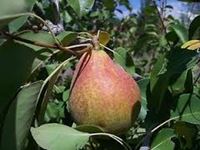
Ayers
This fruit is small to medium size that is yellow with a red blush. It has a sweet flesh that is grit free, and is excellent for eating. This is one of the highest quality pears that can be grown. Ripens mid-August.
Bartlet
Bartlett pear trees (Pyrus communis "Bartlett") are fast-growing, fruit-producing trees that reach heights of 20 feet with an equal spread. Bartlett pears grow in U.S. Department of Agriculture plant hardiness zones 5 through 8. Like other fruit trees, they need full sun and good soil drainage with plenty of water the first few years. They bloom early in the season and the fruit is ready to harvest in late summer or early fall. To produce fruit Bartlett pears need to be planted near another European pear tree, such as "Bosc," for pollination.
Pineapple
This fruit is small to medium size that is yellow with a red blush. It has a sweet flesh that is grit free, and is excellent for eating. This is one of the highest quality pears that can be grown. Ripens mid-August.
Moonglow
A medium dull yellow fruit with pink blush. It has a mildly juicy, soft, white flesh with smooth texture with excellent flavor and very few grit cells. Moonglow pears are great for fresh eating as well as canning. It is a spur-type tree that is fire blight resistant. It requires pollination, ripens mid-September.
Oaks & Hardwood Trees
Chinkapin Oak
A worthy specimen for larger lawns, estates, or parks. A medium to large size oak with dark green leaves in summer turning yellow-orange to orangish-brown in fall. The acorns are at the top of the food preference list for many wildlife species. Grows 40'-50' high with a similar spread
Pin Oak
One of the most popular oaks amongst homeowners, probably due to their fast growth and good shape. Pin oak leaves turn red in the fall and then brown. They hold their leaves throughout the winter until new bud growth pushes them off in early spring. Pin oaks do not do well in soils with high pH levels. Mature height is 60’-70’ and spread is 35’-40’
White Oak
Has blue-green summer foliage with long lasting reddish purple fall color. Acorns are very attractive to wildlife. They are very strong and stately with good disease resistance and drought tolerance. Mature height is 60’-80 with spread of 60’-80’.
Sawtooth Oak
Sawtooth Oak is a medium-sized deciduous tree growing to 25–30 m tall with a trunk up to 1.5 m diameter. The bark is dark gray and deeply furrowed. The leaves are 8–20 cm long and 3–6 cm wide, with 14-20 small saw-tooth like triangular lobes on each side, with the teeth of very regular shape.
The flowers are wind-pollinated catkins. The fruit is an acorn, maturing about 18 months after pollination, 2–3 cm long and 2 cm broad, bicoloured with an orange basal half grading to a green-brown tip; the acorn cup is 1.5–2 cm deep, densely covered in soft 4–8 mm long 'mossy' bristles. It is closely related to the Turkey Oak, classified with it in Quercus sect. Cerris, a section of the genus characterised by shoot buds surrounded by soft bristles, bristle-tipped leaf lobes, and acorns that mature in about 18 months.
Black Walnut
A major characteristic of this tree is its deeply-furrowed, black bark. Trees range in height from 70-150 feet and have a diameter of 2-4 feet. The compound leaves are between 1 and 2 feet long. This tree is prized for its beautiful wood and the tasty nuts which are avidly harvested in the autumn.
Walnut is unquestionably the finest wood in the world. Our forefathers sought it out and used it lavishly in their homes, barns and fences. The warm brown wood finishes beautifully. It is easy to work, yet durable. It shrinks and swells less than any other wood, which makes it valuable to cabinet makers and gunsmiths alike.
Wildlife Bushes
Silky Dogwood
Subtle, four-petaled yellowish-white flowers adorn this shrub appearing in May and June. An excellent choice for any wildlife garden. Attractive, bluish berry-like drupes which ripen in August and September are desired by many bird species. Rounded, multi-stemmed form that grows 6-10' in height with an equal spread. Prefers moist soil and partial sun.
Red Osier
An upright, loose, multi-stemmed, broad-spreading shrub with horizontal branches at the base. The young stems are slender, very smooth, and red. The bark remains a deep red for some time finally turning gray-brown with a rough sandpaper like texture. This is a thicket forming shrub. The fibrous root system holds soil well for use as a bank cover. The foliage is green in summer, but varies in the fall from little color to reddish purple. The cream-white flowers appear in cymes in the spring producing dull white drupes in July to September. The redosier dogwood prefers full sun with an evenly moist soil, but has wide range of tolerance except for extremely dry conditions. Horizontal growth is slow. Pruning needs to be done only once a year. Periodic renewal of this shrub by cutting it back to the ground will allow the red color of the younger stems to show. Plant three to four feet apart for a hedge.
American Plum
American Plum, also known as Wild Plum, is present throughout all of Ohio, and is native to most of the eastern and central United States. It white, pungently sweet blossoms emerge in early spring before the foliage breaks bud. It easily forms colonies and thickets in fields, fence rows, and along roadsides and woodland edges, where its suckers from roots and its germinated seeds create a mass planting similar in mounded appearance to that of wild Sumacs and Crabapples.
Its fruits are sweet when fully ripe, and make excellent jelly or jam due to their high pectin and high acid content. American Plum reaches 20 feet tall by 25 feet wide as an individual specimen under optimum conditions, but forms thickets of indeterminate width with time.
Honey Suckle
There are numberous types of honeysuckles. Most are either large shrubs or twining vines that are noted for their colorful, trumpet-shaped flowers, sweet scent, and attractiveness to butterflies and hummingbirds.
Honeysuckle flowers are magnets for hummingbirds; flower colors include orange, red, yellow, and white, depending on the species and variety. Most shrub honeysuckles grow 6 to 15 feet tall and wide, while the vining types grow 10 to 20 feet tall. Honeysuckles bloom in spring to midsummer.
Blackberry
Blackberries are a very easy fruit to grow. Blackberry bushes are perennials that grow both upwards like a shrub and along the ground like a vine. These vine-like growths are referred to as brambles.
Blackberries are also called dewberries. Boysenberries, loganberries and marionberries are blackberry varieties and not different species altogether.
Black Chokeberry
This small shrub, with a spread of 5 to 6 feet, has large, shiny dark-green leaves that turn purple to orange and red in the fall. Flowers are white with five petals, about ½ inch across. The tart purplish-black fruit is about ¼ inch across and is best used to make jams or jellies. The juice is very high in vitamin C and various antioxidants. Does best in full sun or partial shade. Will grow on a wide variety of soils from wet to very dry
Buttonbush
Found throughout the state in low, wet woods, swamps, and along borders of streams and ponds. The flowers are fragrant, white, round clusters about 1 to 1½ inches across and are a favorite nectar source for bees. Many birds eat the nutlets and nest in the branches. Does best on moist sites
False Indigo
Found statewide in moist ground along streams, rocky banks, and low, wet woods. The flowers are 2 to 6 inches long with dense clusters of purple tube-shaped flowers. This shrub is in the legume family, and the seeds are eaten by quail and other wildlife. Bees and butterflies are attracted to the flowers.
Hazelnut
Also called American filbert, this thicket-forming shrub is found throughout the state on a wide range of soils and sites. The nut is consumed by people and wildlife.
Ninebark
A streamside shrub found over much of the state. Forms a massive root system quickly after planting, making it useful to control erosion on streambanks. It is also used as an ornamental. Its name is taken from the way the mature bark curls away from the stem resembling the number 9.
Redbud
A small to medium understory tree with showy pink flowers in early spring. This legume is an attractive addition to wildlife or windbreak plantings.
Serviceberry
The showy white flowers of this large shrub/small tree are the first to appear in Missouri woodlands each spring. Reddish sweet-tasting fruits are edible but quickly consumed by wildlife. Fall color varies from yellow to orange to red. Found statewide, grows best in partial shade along woodland edges.
Spicebush
The showy white flowers of this large shrub/small tree are the first to appear in Missouri woodlands each spring. Reddish sweet-tasting fruits are edible but quickly consumed by wildlife. Fall color varies from yellow to orange to red. Found statewide, grows best in partial shade along woodland edges.
Conifers
White Pine
White Pines are by far the most popular evergreen tree for this region. White pines exhibit very fast growth and have long soft green needles. When planting as windbreak or in a row, spacing should be 15’ – 20’. Mature height is 50-80’ with a spread of 20-40’.
Eastern Red Cedar
Eastern Redcedar is an evergreen tree that is often seen as a shrub. As a tree, it can grow up to 40 feet tall. They are very narrow and compact. Leaves are scaly and green, and very short.
Eastern Redcedars grow in fields, on roadsides, and in woods as an understory tree. They are often pioneers, meaning one of the first trees to take over a field. The bark of these trees is reddish-brown, and peeling off in shreds.
Norway Spruce
Norway Spruces' are an alternative to the more popular white pine, Norway spruce have shorter and stiffer dark green needles. Growth is a bit slower than white pine but once the roots are established after transplanting they will grow at a good rate. Mature height is 80’ with a 40’ spread.
Planting & Growing Aids
Tree Tube Shelters
Wildlife can be a hassle on freshly planted trees as they crave the new tender leaves. We all want to plant trees to enhance a property and improve the habitat for wildlife. By using tree shelter tubes, it increases the survival rate significantly. The tubes we suggest are 4 feet and 5 feet in height. These tubes not only protect the trees up to that height but also aid in faster growth rates. The protectors stay on the tree until the tree outgrows it. We strongly recommend the use of tree shelter tubes as they significantly increase survival and growth rates and they are the best way to insure your investment.







